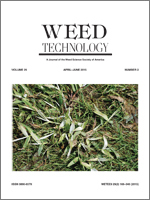Metribuzin has a 60-d preharvest interval (PHI) in potato, which limits utility of metribuzin POST in potato. In certain years, the potato may not fully cover the area between the potato rows. This allows for late-season weed emergence and subsequent yield reduction through direct competition or harvest interference. Field experiments were conducted in 2011 at Castle Hayne, NC; Freeville, NY; Hasting, FL; and Plymouth, NC to determine the effect of a 30-d PHI on potato crop tolerance. The cultivars planted were ‘Superior' and ‘Yukon Gold' in Castle Hayne and Plymouth, ‘Castille' and Yukon Gold in Freeville, and ‘Atlantic' in Hastings. Treatments included metribuzin at 278 g ai ha−1 PRE, 30, and 60 d before harvest (DBH), and metribuzin at 556 g ha−1 at 30 and 60 DBH. Split application treatments included metribuzin at 556 g ha−1 at PRE followed by metribuzin at 556 g ha−1 30 or 60 DBH and metribuzin at 842 g ha−1 PRE followed by metribuzin at 278 g ha−1 at 30 or 60 DBH. Potato injury was ≤ 8% at all locations, and injury was transient. There were no differences observed between metribuzin rate or application date for individual potato grades or total yield. Reducing the PHI in potato to 30 d would have no effect on yield and would provide a longer period for controlling broadleaf weeds.
Nomenclature: Metribuzin; potato, Solanum tuberosum L.
Metribuzin tiene intervalo de aplicación antes de la cosecha (PHI) de 60-d en papa, lo cual limita la utilidad de metribuzin POST en papa. En algunos años, la papa podría no cubrir totalmente el área entre las hileras de siembra. Esto permite la emergencia de malezas tarde durante la temporada de crecimiento y la subsecuente reducción en el rendimiento debido a la competencia directa o la interferencia con la cosecha. En 2011, se realizaron experimentos en Castle Hayne, North Carolina; Freeville, NY; Hastings, FL; y Plymouth, North Carolina, para determinar el efecto de un PHI de 30-d sobre la tolerancia del cultivo de papa. Los cultivares que se plantaron fueron 'Superior' y 'Yukon Gold' en Castle Hayne y Plymouth, 'Castille' y Yukon Gold en Freeville, y 'Atlantic' en Hastings. Los tratamientos incluyeron metribuzin a 278 g ai ha−1 PRE, 30 y 60 d antes de la cosecha (BDH), y metribuzin a 556 g ha−1 a 30 y 60 DBH. Los tratamientos con aplicaciones divididas incluyeron metribuzin a 556 g ha−1 en PRE y seguido de metribuzin a 556 g ha−1 30 ó 60 DBH. El daño de la papa fue ≤8% en todas las localidades, y el daño fue transitorio. No se observaron diferencias entre dosis de metribuzin o fechas de aplicación en ninguna de las diferentes categorías de papa o el rendimiento total. El reducir el PHI en papa a 30 d no tendría efecto alguno en el rendimiento y brindaría un período más largo para el control de malezas de hoja ancha.





